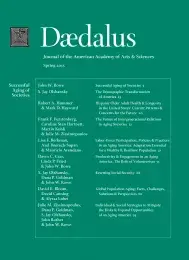Labor-Force Participation, Policies & Practices in an Aging America: Adaptation Essential for a Healthy & Resilient Population
Population aging in the United States poses challenges to societal institutions while simultaneously creating opportunities to build a more resilient, successful, and cohesive society. Work organization and labor-force participation are central to both the opportunities and challenges posed by our aging society. We argue that expectations about old age have not sufficiently adapted to the reality of aging today. Our institutions need more adaptation in order to successfully face the consequences of demographic change. Although this adaptation needs to focus especially on work patterns among the “younger elderly,” our society has to change its general attitudes toward work organization and labor-force participation, which will have implications for education and health care. We also show that work’s beneficial effects on well-being in older ages are often neglected, while the idea that older workers displace younger workers is a misconception emerging from the “lump-of-labor” fallacy. We conclude, therefore, that working at older ages can lead to better quality of life for older people and to a more productive and resilient society overall.
Population aging in the United States, as in most countries around the world, poses many challenges to our major private, public, and societal institutions. At the same time, however, it creates great opportunities for building a more resilient, successful, and cohesive society. For several reasons, work organization and labor-force participation are central to both opportunities and challenges posed by an aging population. First, for all but a very few, working remains the main source of income for consumption and for savings. Work also has an anchoring function in society, bringing multiple benefits to our physical, social, and emotional well-being. Given the continuing increase in life expectancy in aging societies, it is more necessary than ever before to revisit the role of work in older ages and the opportunities that longer working lives can bring to aging societies. We argue in this essay that individual expectations about old age have not sufficiently adjusted to the new reality of an aging society. Reflecting this, our private, public, and societal institutions suffer from the same disconnect and now need to adapt considerably to face the challenges and embrace the opportunities of demographic change. Although this adaptation must focus especially on work patterns among the “younger elderly,” our entire society has to adapt its attitudes toward work organization and labor-force participation, and in the process rethink its education and health care policies and expectations. . . .
